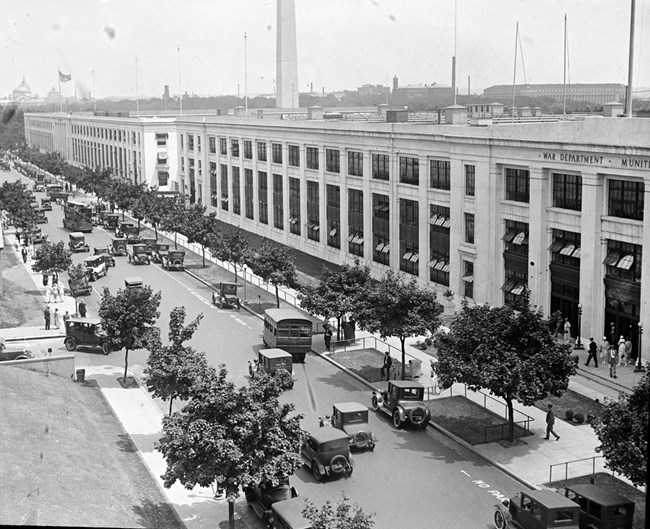Last updated: July 18, 2017
Article
'Temporary' War Department Buildings

(Library of Congress)
When crossing the bridge to ‘Signer’s Island”, a visitor to Constitution Gardens would never guess that the lake and surrounding landscaping was once the site of sprawling, and not-too-particularly pleasing to the eye, federal office buildings. Built for “temporary” service during WWI two enormous buildings occupied the land between Constitution Avenue and the reflecting basin. Construction of the four-story steel- and-concrete buildings took less than six months. The buildings were known as the Main Navy Building and the Munitions Building. They were erected under the auspices of assistant Secretary of the Navy, Franklin D. Roosevelt to accommodate a rapidly expanding war-time military bureaucracy. Little did anyone know that the buildings would survive through Roosevelt’s four terms as president and well beyond.
Roosevelt, in an August 19, 1941 press conference noted the origins of the tempos as well as his distaste for them:
“When I first came down here in 1933, I said I didn't think I would ever be let into the Gates of Heaven, because I had been responsible for desecrating the parks of Washington. Back in the fall of 1917, the Navy Department needed space, and I took up with President Wilson the possibility of building a temporary building— wooden building— down here on the Oval. And he said, "Why do you select that site?" I said, "Mr. President, because it would be so unsightly right here in front of the White House, that it just would have to be taken down at the end of the war." "Well," he said, "I don't think I could stand all that hammering and sawing right under my front windows." He said, "Can't you put it somewhere else?" So I said, "Of course. Put it down in Potomac Park." "Well," he said, "put it down there and we will get rid of it."

Library of Congress
The second generation tempos, from the air, resembled gap-toothed combs, with regularly spaced wings extending from a long spine that ran the length of the building. The two-story buildings were strictly utilitarian and provided a jarring aesthetic contrast to the surrounding memorials and museums.
Even following the war, with the Pentagon complete, the tempos were still beehives of activity housing a variety of federal bureaus and departments. It wasn’t until the Kennedy administration that the buildings started to be razed and the current form of the parkland extending from the Lincoln Memorial to the Washington monument began to be reclaimed and restored to would eventually become its present-day appearance.

Carol Highsmith
From what FDR called the “the desecrating of the parks of Washington” came the beautiful and rolling grounds of Constitution Gardens and the Vietnam Veteran’s Memorial. Beauty, majesty, and remembrance finally found permanence along the reflecting basin and in the panorama of what has come to be known as our nation’s “front lawn”.

NPS
